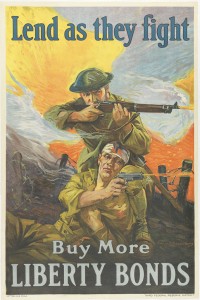 July 28th marks the anniversary of the event that proved to be the start of World War I in 1914.
July 28th marks the anniversary of the event that proved to be the start of World War I in 1914.
A month before the war began, on June 28, Archduke Franz Ferdinand, heir to the Austro-Hungarian Empire, and his wife Sophie had been assassinated during a trip to Bosnia. Initial outrage was strong, as were fears that this would be the instigating event for the European war that had been brewing for years. But as the days and weeks passed without Austria-Hungary retaliating against Serbia (whom they believed to be behind the assassination plot), some began to breathe a sigh of relief.
But then, on July 23, Austria-Hungary issued an ultimatum to Serbia with various demands regarding Serbia’s response to the assassination and the country’s future relationship with Austria-Hungary. Serbia accepted many of the demands but refused to allow Austria-Hungary to be involved in its judicial process for Serbians connected to the assassination. Thus rejected, the Austro-Hungarian Empire declared war on Serbia on July 28. International alliances formed over the previous decades were invoked. Within weeks, the major powers were at war and the conflict soon spread around the world.
Russia (a champion of Serbia and its Slavic population) began mobilization of its troops, which prompted Germany (an ally of Austria-Hungary) to declare war on Russia. In quick succession, the system of alliances (and territorial ambitions) within Europe led Germany to also declare war on France and Britain, Britain and France to declare war on Germany, and Russia to declare war on Germany and Austria-Hungary.
Within a week, five major countries in Europe were embroiled in a war they believed would be over in a matter of months. Alliances were formed; it was the Allies (the United Kingdom, France and the Russian Empire) versus the Central Powers (Germany and Austria-Hungary). These alliances were both reorganized and expanded as more nations entered the war: Italy, Japan and the United States joined the Allies, and the Ottoman Empire and Bulgaria joined the Central Powers. Ultimately, almost 70 million military personnel, including 60 million Europeans, were mobilized in one of the largest wars in history.
The war approached a resolution after the Russian government collapsed in March 1917, and a subsequent revolution in November brought the Russians to terms with the Central Powers. On the 4th of November 1918, the Austro-Hungarian Empire agreed to an armistice. After the Allies drove back the Germans in a series of successful offensives and began entering the trenches along the western front, Germany agreed to an armistice on the 11th of November 1918, ending the war in victory for the Allies.
When the war began the United States proclaimed a united policy of strict neutrality. However, after German submarines sank seven U.S. merchant ships, President Woodrow Wilson went to Congress calling for a declaration of war on Germany, which Congress passed on April 6, 1917. Although the United States was never formally a member of the Allies, it became a self-styled “Associated Power”. The United States had a small army, but, after the passage of the Selective Service Act, it drafted 2.8 million men and, by the summer of 1918, was sending 10,000 fresh soldiers to France every day. During the war, the US mobilized over 4,000,000 military personnel and suffered 110,000 deaths, including 43,000 due to the influenza pandemic of 1918.
By the end of the war, four major imperial powers, the German, Russian, Austro-Hungarian and Ottoman empires, ceased to exist. Germany and Russia lost substantial territory, while the Austro-Hungarian and the Ottoman Empires were dismantled. The maps of Europe and Southwest Asia were redrawn, with several independent nations restored or created.
The League of Nations was formed with the aim of preventing any repetition of such an appalling conflict. This aim, however, failed with weakened states, renewed European nationalism and the German feeling of humiliation contributing to the rise of fascism. All of these conditions eventually led to World War II.
World War I lasted more than four years (28 July 1914 – 11 November 1918) and resulted in upwards of 37 million dead, missing, or wounded soldiers. The total number of participating personnel is estimated by the Encyclopedia Britannica at 65,038,810 with approximately 9,750,103 military deaths during the conflict.
There are no remaining veterans of World War I. Frank Woodruff Buckles (born Wood Buckles, February 1, 1901 – February 27, 2011) was a United States Army soldier and the last surviving American veteran of World War I. He enlisted in the U.S. Army in 1917 and served with a detachment from Fort Riley, driving ambulances and motorcycles near the front lines in Europe.
The last living veteran of World War I was Florence Green, a British citizen who served in the Allied armed forces, and who died 4 February 2012, aged 110. The last combat veteran was Claude Choules who served in the British Royal Navy (and later the Royal Australian Navy) and died 5 May 2011, aged 110. The last veteran who served in the trenches was Harry Patch (British Army) who died on 25 July 2009, aged 111. The last Central Powers veteran, Franz Kanstler of Austria-Hungary, died on 27 May 2008 at the age of 107.
There are still children of WWI veterans living, but even they are passing. Now is the time to record family memories of stories told on the knees of the fathers and grandfathers who were among those first boys and men drafted to fight. Once these children are gone, the stories and memories will become scarcer and scarcer. Help preserve them by writing them down, sign and date and save them for future generations.
picture: wikipedia.com